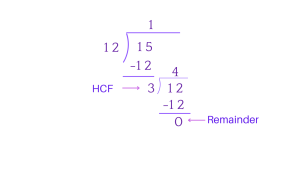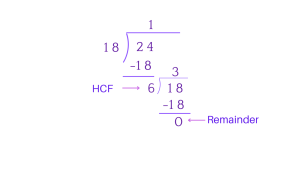How to find Highest Common Factor? – Methods and Example
Table of Contents
Introduction
Highest Common Factor or Greatest Common Divisor
In the realm of mathematics, the term “Highest Common Factor” (HCF) or “Greatest Common Divisor” (GCD) often comes into play when dealing with numbers and their factors. Let’s delve into the world of HCF/GCD and explore its significance in solving mathematical problems.
Analogy of Definition
What is Highest Common Factor (HCF)?
The Highest Common Factor (HCF) or Greatest Common Divisor (GCD) of two or more numbers is the largest positive integer that divides each of the numbers without leaving a remainder. In simpler terms, it is the greatest common factor shared by the given numbers.
Method
How to Find the HCF/GCD?
There are several methods to find the HCF/GCD of numbers.
HCF/GCD by Listing Method
One common method is the listing factors method, where you list the factors of each number and identify the greatest common factor.
Example: Find the Highest Common Factor of 24 and 36
Factors of 24: 1, 2, 3, 4, 6, 8, 12, 24
Factors of 36: 1, 2, 3, 4, 6, 9, 12, 18, 36
Since the highest common factor of the two is 12, HCF = 12
HCF/GCD by Prime Factorization Method
Another method involves using prime factorization to find the HCF, breaking down each number into its prime factors and identifying the common prime factors.
Example: Find the LCM of 15 and 20
Prime Factors of 15: 3 * 5
Prime Factors of 20: 2 * 2 * 5
Since the highest and the only common prime factor is 5, HCF = 5
HCF/GCD by Division Method
The division method is also used to find the HCF by repeatedly dividing the numbers until the remainder is zero.
Example: Find the HCF of 12 and 15.
Step 1: Find out the lower number, which is 12 in this case. So, we divide 15 by 12.
Step 2: Dividing 15 by 12, gives us the remainder 3 which will be the new divisor and 12 will be the new dividend. We will then carry out the division again.
Step 3: We will continue to divide until we get the remainder 0 and the divisor with which we get 0 as the remainder is the HCF or GCD. In this case, the divisor 3 has given the remainder 0, so HCF = 3

Relationship between HCF and LCM
The relationship between HCF and LCM is a crucial aspect of number theory. The product of the HCF and LCM of two numbers is equal to the product of the numbers themselves. This relationship is expressed as: HCF(a, b) * LCM(a, b) = a * b, where a and b are the given numbers.
HCF of Three Numbers
To find the Highest Common Factor of three numbers, you can use the methods of listing factors, prime factorization, or division. By applying these methods, you can determine the greatest common divisor shared by all three numbers. To
HCF of Four Numbers
Similar to finding the Highest Common Factor of three numbers, the HCF of four numbers can be found using the listing factors method, prime factorization, or division method. The goal is to identify the largest common divisor among all four numbers.
HCF of Prime Numbers
When dealing with prime numbers, the Highest Common Factor (HCF) is relatively straightforward. The HCF of two or more prime numbers is always 1, as prime numbers have no common factors other than 1.
Find out more about numbers on our site, ChimpVine!
Examples
Finding the Highest Common Factor (HCF) of 18 and 24
Method 1: Listing Factors
Factors of 18: 1,2,3,6,9,18
Factors of 24: 1, 2, 3, 4, 6, 8,12,24
Common factors: 1, 2, 3, 6
Greatest common factor: 6
So, the HCF of 18 and 25 is 6
Method 2: Prime Factorization
Prime Factors of 18: 3*3*2
Prime Factors of 24: 2*2*2*3
Common factors: 2 *3 = 6
Hence 6 is the HCF
Method 3: Divsion Method

Hence, the Highest Common Factor is 6.
Quiz
Tips and Tricks
1.Prime Factorization Method
Break down each number into its prime factors, then identify the common prime factors and multiply them together. This product will be the Highest Common Factor (HCF).
2.Division Method
Take the two numbers and perform repeated division to find their common factors. The highest common factor will be the greatest number that divides both without leaving a remainder.
3.Using a Table
Make a table listing the factors of each number and identify the common factors. The greatest common factor among the common factors is the HCF.
4.Using Multiples
Write down the multiples of each number and identify the common multiples. The highest common multiple that both numbers share is the HCF.
5.Using Exponents
Express each number in terms of its prime factors with exponents. The HCF is the product of the common prime factors raised to the lowest exponent.
Real life application
Story: “The HCF Adventure of Emma and Noah”
Emma and Noah, two inquisitive siblings, embarked on an adventure that led them to discover the practical applications of the concept of HCF in various real-life scenarios.
Challenge 1: The Cake Baking Conundrum
Emma and Noah decided to bake a cake using recipes that required 3 cups, 4 cups, and 5 cups of flour. They needed to determine the greatest amount of flour that could be measured using all three recipes without any leftover flour. By finding the HCF of 3, 4, and 5, which turned out to be 1, they realized that they could measure any amount of flour without wastage.
Challenge 2: The Garden Planting Puzzle
As they explored a botanical garden, Emma and Noah encountered three flower beds with 24, 36, and 48 flowers. They wanted to plant the same number of flowers in each bed without any remaining flowers. By finding the HCF of 24, 36, and 48, which turned out to be 12, they successfully planted 12 flowers in each bed.
Challenge 3: The Music Playlist Dilemma
In their final challenge, Emma and Noah were tasked with creating a playlist of songs with durations of 30, 45, and 60 seconds. They needed to determine the greatest duration before the playlist repeated a song. By finding the HCF of 30, 45, and 60, which turned out to be 15, they ensured that the playlist did not repeat a song until 15 seconds had passed.
FAQ's
Like? Share it with your friends
